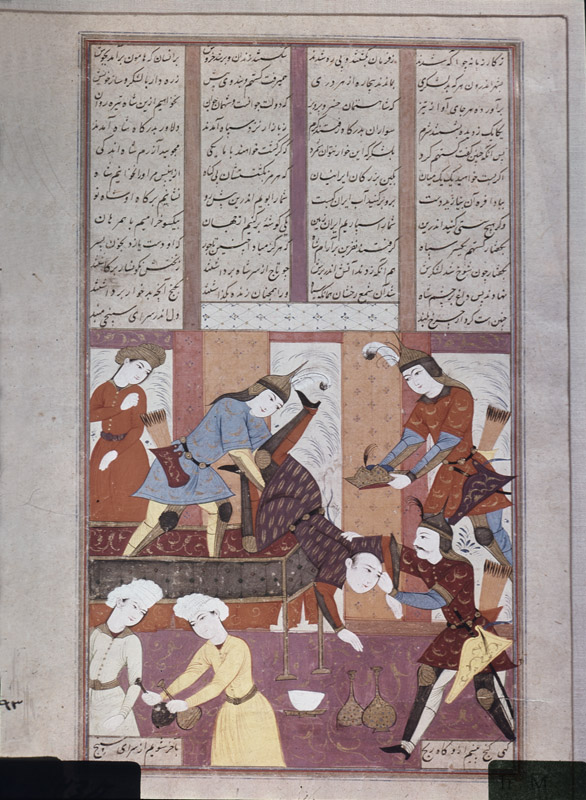Moʿin Moṣavver | Manuscripts | Shahnama of Ferdowsi
Manuscript E, no. 8-232
Benduy and Gostaham Assassinate Hormozd
Location: Aga Khan Museum, Toronto. Formerly in the Prince Sadruddin Aga Khan Collection, no. Ir.M 43/I
Page: 36.2 x 22.7 cm (after Grube)
Painting: 15.5 x 14.3 cm.(after Grube)
Text area: 24.5 x 14.3 cm (scaled)
Text: four column; deepest column 13 lines on a 30 line per full page matrix.
Illustration number: The number 93 written in Arabic numeral, presumably of later date, appears in the upper left corner, probably indicating that it was the ninety-third painting in the manuscript.
Following his defeat by Bahrām Čubina, Ḵosrow Parviz fled with his close entourage to the King of Rum. Before going very far, two of his companions, Benduy and Gostaham, dropped back and returned to the palace, where they assassinated Hormozd. The painting is almost square in shape. In the center Shah Hormozd, in a purple robe, is being toppled headlong from his throne by three warriors. One of them, wearing purple in the lower right, can be identified as Hormozd’s brother, Benduy. It is uncertain whether Gostaham is the warrior in a light blue coat at the upper left who is assisting Benduy in the toppling of Hormozd, or the vermilion clad soldier in the upper right who has lifted the crown from the shah’s head. Three other figures are portrayed in the scene, all wearing long robes and turbans, and all apparently attendants of the shah. Two in the lower left foreground, dressed in yellow and beige respectively, are hastily gathering flacons. The third attendant, clad in vermilion, turns his back to the event, and is apparently about to make a quick exit to the upper left. The setting is the interior of the shah’s palace at Ctesiphon. A purple carpet with gold decoration is on the floor in the foreground, on which is set two decanters and a bowl. In the background is a wall tiled in alternating strips of orange, purple, and rose-pink, with three inset rectangular white panels delicately painted with foliage.
There are four columns of text above the painting. The two outer columns are comprised of twelve lines of text each, and the center columns of only eleven lines each. In addition, there are two single lines of text below the painting, each vertically aligned with the two outer columns above the illustration. A rectangular ruled frame encloses illustration and text. The painting is signed in the center of the lower margin in minuscule characters that seem to be in Moʿin’s hand: raqam-e kamina moʿin-e moṣavver. No date is indicated.
For an earlier version of this subject painted by Moʿin, cf. Ms. D, f. 175.
.
Painting references:
Grube, MMP_1962, #114.
Welch, AK2_1972, Ir.M. 43/I.
Text references:
Warner, VIII, p.232. Mohl, VII, pp.47-48. Levy, p. 355.
Photo courtesy of Prince Sadruddin Aga Khan
Robert Eng
Last Updated: May 5, 2013 | Originally published: June 23, 1997
Manuscript E, no. 8-232
Benduy and Gostaham Assassinate Hormozd
Location: Aga Khan Museum, Toronto. Formerly in the Prince Sadruddin Aga Khan Collection, no. Ir.M 43/I
Page: 36.2 x 22.7 cm (after Grube)
Painting: 15.5 x 14.3 cm.(after Grube)
Text area: 24.5 x 14.3 cm (scaled)
Text: four column; deepest column 13 lines on a 30 line per full page matrix.
Illustration number: The number 93 written in Arabic numeral, presumably of later date, appears in the upper left corner, probably indicating that it was the ninety-third painting in the manuscript.
Following his defeat by Bahrām Čubina, Ḵosrow Parviz fled with his close entourage to the King of Rum. Before going very far, two of his companions, Benduy and Gostaham, dropped back and returned to the palace, where they assassinated Hormozd. The painting is almost square in shape. In the center Shah Hormozd, in a purple robe, is being toppled headlong from his throne by three warriors. One of them, wearing purple in the lower right, can be identified as Hormozd’s brother, Benduy. It is uncertain whether Gostaham is the warrior in a light blue coat at the upper left who is assisting Benduy in the toppling of Hormozd, or the vermilion clad soldier in the upper right who has lifted the crown from the shah’s head. Three other figures are portrayed in the scene, all wearing long robes and turbans, and all apparently attendants of the shah. Two in the lower left foreground, dressed in yellow and beige respectively, are hastily gathering flacons. The third attendant, clad in vermilion, turns his back to the event, and is apparently about to make a quick exit to the upper left. The setting is the interior of the shah’s palace at Ctesiphon. A purple carpet with gold decoration is on the floor in the foreground, on which is set two decanters and a bowl. In the background is a wall tiled in alternating strips of orange, purple, and rose-pink, with three inset rectangular white panels delicately painted with foliage.
There are four columns of text above the painting. The two outer columns are comprised of twelve lines of text each, and the center columns of only eleven lines each. In addition, there are two single lines of text below the painting, each vertically aligned with the two outer columns above the illustration. A rectangular ruled frame encloses illustration and text. The painting is signed in the center of the lower margin in minuscule characters that seem to be in Moʿin’s hand: raqam-e kamina moʿin-e moṣavver. No date is indicated.
For an earlier version of this subject painted by Moʿin, cf. Ms. D, f. 175.
.
Painting references:
Grube, MMP_1962, #114.
Welch, AK2_1972, Ir.M. 43/I.
Text references:
Warner, VIII, p.232. Mohl, VII, pp.47-48. Levy, p. 355.
Photo courtesy of Prince Sadruddin Aga Khan
Robert Eng
Last Updated: May 5, 2013 | Originally published: June 23, 1997
